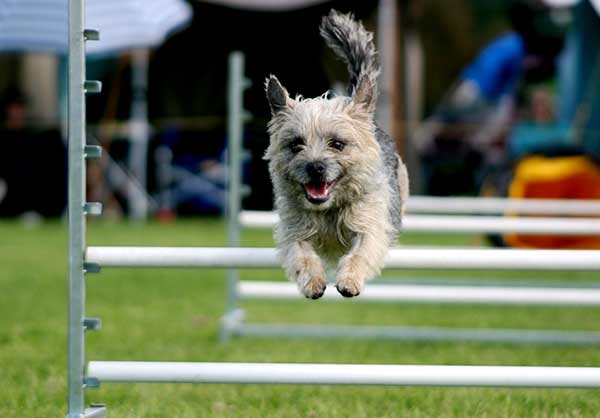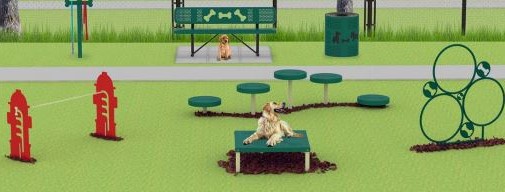 A happy terrier gets a workout on dog park equipment. More dog owners are realizing the benefits of training their dogs on this equipment for exercise and learning commands
A happy terrier gets a workout on dog park equipment. More dog owners are realizing the benefits of training their dogs on this equipment for exercise and learning commands
By Gerald Dlubala
Think about the difference a few pieces of dog park equipment can make to a dog and their owner.
Research says that the relationship we have with our dogs is based on thousands of years of evolution.
Going back up to 8,000 years, dogs have been found buried next to their human counterparts, sometimes outfitted in extravagant collars, expensive robes, and laid next to gem-laden spoons and bowls.
The bond is not just emotional, say scientists. More recent studies have shown that when humans and dogs are together and making eye contact, the dog in fact, experiences the release of the hormone oxytocin as humans.
What is oxytocin, you ask? Well, that's the same hormone released when a mother lovingly looks upon her baby in her arms. So it's no wonder that there is such a bond between humans and their dogs. It's almost chemically impossible not to do so.
This special bond is very evident in the field of dog agility training and the use of dog park equipment. When you see the unspoken communication happening between dog and handler, it sure seems there is more to it than just a promised treat at the end of 60 seconds of highly choreographed activity.
Dog agility competitions on the rise
Dog agility has its roots based on an exhibition back in the 1970s when a group of dogs, during a break at a dog show, were led around a few basic jumps, similar to horse jumping.
One thing led to another, and you now have a sport that is rapidly growing with competitions available nearly every weekend.
And with agility courses being laid out in ever-changing patterns, the sport of dog agility competition has become more challenging, rewarding, and just plain fun to watch.
In addition, many pet owners now see recreational agility training as a great way to exercise and teach their dogs.
Dog agility equipment basically remains the same within the competitions. But how the equipment is laid out and sequenced is increasingly challenging for both the dogs and their handlers, encountering some of these combinations, or all of the following:
- Basic walks/ramps and tables
- Hoops and Jump Overs
- Teeter totters, A-Frames, Tables
- Weave poles
- Tunnels, barrels
When these pieces are laid out in a course for the dogs to follow, whether in a competition arena or in a dog park setting, you have dog playground equipment that both challenges, and benefits the dogs and the handlers.
Benefits of agility training on dog park equipment
"Agility training and competitions provide mutual benefits for the dog and the trainer alike", says Beth Hemmer, a St. Louis-based veteran of agility training and competitions. Hemmer, who competes in AKC and ASCA agility competitions about twice a month on average, says there are many benefits to the sport, but three main areas are equally beneficial for the dog and handler.
- Physical Benefits. Yes, this one may the most obvious, but our dogs need to be active and use their natural instincts. "And so do the handlers", says Hemmer. "Because of the demands of the courses, if you want to compete, you have to train." These natural instincts are challenged with quick movements, changes in direction, and a combination of activities like running, jumping, crawling and sprinting. As the handler and trainer, the daily regimen of getting out and running alongside your dog, leading them through tunnels, weave poles, jumps and more provides a great cardio workout of twists, turns and flexes, all while doing something you love, has always been the key to a successful exercise regimen. Stamina and endurance are a great, natural byproduct.
- Mental Benefits. This is a biggie. "The courses have become more and more complex", says Hemmer, "and are now designed to challenge the handler as much as the dog. They are not the simple straight-line courses of yesteryear. These courses now demand more strategic ways of execution, trying to save steps here and there while making sure the dog understands and responds to your choreographed moves." The handlers have to stay mentally sharp to constantly retain their creativeness while keeping their dogs motivated.
- Social Benefits. When you think about what these dogs have to learn in order to participate, they are really learning acceptable behavior patterns. Basic commands while dealing with distractions make them more socialized while keeping them safer as well. Agility dogs are highly socialized dogs, love being around other dogs and people, yet they are willing to obey basic commands when needed. The handlers benefit from the social aspect as well. "Competitors on the course, they are a close-knit group that becomes friends, allies, and a true support group off the course," says Hemmer. The agility competitions become a great venue to meet, spend and enjoy time with like-minded people. These people have not only become friends during the competitions, but they have become friends for life outside of the agility aspect.
As spectators, we follow these agility competitions with amazement at how in tune, and in sync the handlers are with their dogs. There seems to be a connection of the minds. The handlers are energetic, positive and happy. The dogs are active yet well behaved, obviously having a blast darting from activity to activity, in and out of tubes and tunnels, over jumps and teeter totters, and around posts.
Then, when the course has been completed, these dogs happily jump into the outstretched arms of their handlers.
Rewards are not just for professionals
Like many of us, you might be thinking of how cool it would be to have that type of connection with your family dog. But you're not a trainer by any means, and you certainly don't have the time to run around every couple of weeks to these demonstrations and competitions.
And then, when you look at your family pooch you don't necessarily think "agility dog", hehe.
You can, however, still experience the benefits of dog agility training.
 To instantly create an area for dog playground equipment, consider purchasing a dog park kit where the agility products are bundled together
To instantly create an area for dog playground equipment, consider purchasing a dog park kit where the agility products are bundled together
With the continued growth of the sport, more and more dog parks are installing dog park equipment with simple agility products as exercise options for you and your dog to use while visiting.
Talk to other dog owners at the park. Form a group. Create a Facebook page. Start a petition. Approach the parks department about adding some dog park equipment such as hoop jumps and simple hurdles.
If funds are not available, wait until the next round of budgeting and make your pitch then. Local council members do respond to crowds. Be sure to bring up the fact that the ASPCA says nearly 44% of American households now own a dog. And frankly, dog park equipment would not be a major expenditure.
Another option is to conduct a fund-raiser to generate your own funds for the dog park equipment. Ask some businesses such as local veterinarians or pet shops to be sponsors and add a plaque with their name.
If you live at an HOA or multi-family community, ask the managers to budget some dog park equipment for residents and their pets. It's a great way to add value to the property for marketing purposes as well, since so many potential tenants will own dogs.
If you're not around an equipped dog park, you can purchase individual pieces of dog agility equipment to use in your own backyard. Share the expense with a few friends.
While it may not have crossed your mind, Hemmer says "Equipment for home and backyard use is becoming more common, with some vendors now showing up at competitions with equipment ready to be sold to interested consumers".
The backyard audience is there, looking for a way to incorporate the benefits of agility type exercise into their own lifestyle with their own dog park equipment.
While most of us likely don't have the yard or green space needed to support a dog agility course, Hemmer says there are ways to adapt. "Just look for equipment that is versatile, can have multiple uses, and will provide one or two drills for your dog and family to enjoy and have fun with." Her suggestions for viable backyard agility training and exercise options include:
- Jumps. They're portable, easily moved when needed, and provide a variety of uses depending how you set them up.
- Wave Poles. Easily moved and can be used as obstacles as well as slalom areas.
- Tunnels. Very portable and easily moved, they can also be shaped in different ways and lengths to vary the exercise.
- Contact Obstacles. These can be less portable because of weight and bulkiness, including the A-Frames, walk boards, and teeter-totters. They can still be used in different types of exercises, depending how they are set up, laid out, or even tipped on their sides for a different look and height.
Home based dog agility exercises are a creative and healthy option
Using agility based exercises and principles in your home environment can be a unique and creative way to enhance the bonding and trust between you, your family, and your dog, provided you all use the same commands for the same exercises.
Basic commands are reinforced, trust is built, and a form of communication is achieved.
These benefits will ultimately improve your dog's behavior, both within the family and out in social situations during unlimited distractions.
When performed as a family, your quality time is increased and spent out of doors instead of succumbing to the sedentary technology drain that occupies our time indoors.
Ultimately, you are becoming a physically active family while training your dog to be a better family member as well, and that may be the biggest benefit of all.


